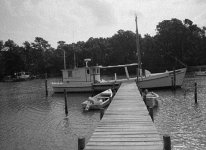Diggin99
Established
I have now developed three rolls of film the last two are terrible. I realize that there are so many problems that might be wrong I am not sure what to think. So to explain...film used was Delta 400. I developed one roll with D-76 and the other with R09. The technique used was the same...as recommended by Ilford in their "Processing your first Black and White film" pamplet. The picture below was devloped in R09 at a dilution of 1+40 at 68 degrees for 14 minutes. I find that doing this on my own has the disadvantage of not being able to learn from my misstakes...since no one with darkroom experience is here to advise me! So I turn to you and ask for your thoughts! The image was scanned into photoshop at 300 dpi...no changes were made other than to crop and then invert the image...
Many thanks!
Nancy

Many thanks!
Nancy




